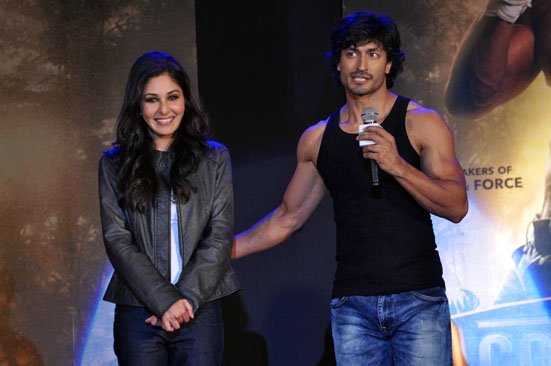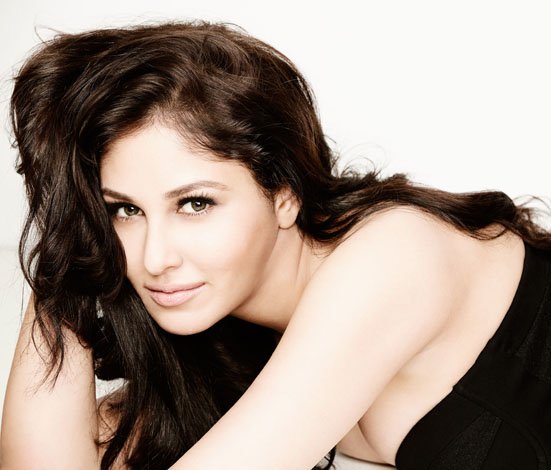
Pooja Chopra was the winner of the Femina Miss India Pageant 2009-2010 (she was also a semifinalist at Miss World and won the Beauty With A Purpose award). Though we’ve had many Miss India winners who have gained prominence, Pooja’s story is a tale of the unexpected. When Pooja was born, her mother ended up leaving her father because he did not want a second girl child and she raised her two daughters with a lot of struggle. Her victory signified great hope. Minority-Review’s Swati Sharan speaks with Pooja on her social stances, modeling, films and more.
Was the seed of wanting to be a Miss India something that grew inside you as a teenager?
It is very funny because I was quite a tomboy. And I would never have imagined even in college that I would ever end up becoming a Miss India. They were all so poised, well mannered and graceful and dolled up. It was quite beyond my imagination. It just happened that at one of the fashion shows we had in our college, one of the girls met with an accident and I was asked to replace her. So I replaced her. Then there was a local choreographer who picked me up to do some catalogue shoot for these garments. And I just did the shoot because I got extra cash. But then I said, okay, why not? And then I modelled with my short boy-cut hair. And that’s it. And then those pictures were splashed in magazines and on hoardings.
And then things just kept happening. I liked the feeling when my friend told me, “We showed your hoarding to our family and told them she’s our friend.” So somewhere I started feeling really nice about it. I did several ramp shows with my colleague Tanushree Dutta. She went on to win Miss India. So that’s how I got to thinking that even I should try it out. So for 5 years I watched all the CDs of the Miss India pageant and the questions they ask and the kind of clothes they wear. There’s a lot of study and preparation that I went through very happily.
What are your thoughts on modeling?
I’m not modeling anymore. I’m doing films. I already did one film called Commando. It was released on the 12th of April 2013, and it did extremely well. And now we’re going to be shooting for the sequel of Commando. See, after I won Miss India, which was about 4 years ago during 2009-2010, there were a lot of commitments that I had. You represent the country. So for a year you have your appearances, sponsor commitments and you’re travelling. And since I’d fractured my leg, I was on the bed for about 3 months. That was in 2010. So it was a gradual progression. I can’t say there was any thought or dreamt about. I was not closed to doing films. But only if I got something nice. And yes, this was something really nice. And I’m glad I waited for this. Because if I’d taken up random things that came my way, I’m sure I would have regretted it. So it’s like they say, faith has paved the way.

Pooja Chopra with her leading man Vidyut Jamwal at their film Commando’s promotional event
So many big stars are earning big bucks from modeling; it’s surprising you would give it up for films…
I haven’t given up modeling. It’s just that I don’t enjoy it too much. Since acting is new, it’s more fun. Something new is always more exciting. Modeling is something where you are smiling, posing with different dresses and clothes. But acting is dimensional where you are playing a character and convincing people that you are that person. It’s more challenging. I’ve done modeling for 4 years. It’s not as challenging. I like to do it but I don’t enjoy doing it.

Kareena Kapoor and Aishwarya Rai Bachchan keep doing films and ads…
Well, there’s good money so obviously, I mean, why would a Kareena or Ash not model? If you’re a brand ambassador and a poster face of good products, it always adds to your brand value.
Speaking of brand ambassadors, were you asked to be a brand ambassador for any products?
Yes, I’ve endorsed products like Tata Docomo, Bajaj Allianz, NIFD Flying Cats, Richfield and more. There’s a whole list you can get on Wikipedia.
You support the Nanhi Kali project. Could you tell us something about it?
Nanhi Kali is an NGO, which supports 50,000 girls from all parts of the country like the backward regions of India. In India they have this thing where they do not educate the girls and believe only the guys deserve to be educated as they are the breadwinners of the family. The girls eventually have to get married and settle down and then there’s no use educating them: it’s wasting money according to them. So Nanhi Kali is a foundation (www.nanhikali.org) where they educate these girls. They have given them basic things including uniforms, pencils and books.
After I won the Miss India pageant, I of course, had certain credibility and there were a lot of companies I was involved with. So I asked them to donate some money and we were able to collect some $10,000 USD or more than that. It’s about 12 lakhs in Indian currency so it was good money. That helped most of the kids. And then after this, I have requested the companies to donate to this charitable organisation directly. And I personally take care of two girls for their studies and education every year. Every 6 months when they have their exams, I get their reports so I email them. I go and meet them also once in awhile. I’ve sponsored them for as long as they want to study. Both of these girls are very brilliant.

So you’re able to have a personal relationship with these girls too?
Yes. Because I’m sponsoring their education they need to know who’s paying for them. They also get motivated to work hard. So like if I say if you come 2nd in class instead of 5th, then next midterm I’ll take you out maybe for shopping or get them nice things. One is in 6th standard and the other one is in 8th. So they need some motivation, some drive. As kids, our parents did it all for us. So if we could do that for somebody I think that would be great.
And the cost of sponsoring is a very petty amount: about Rs 2400 a year for kids from class 1-5 or Rs 3600 a year for kids from class 6-10, which is a paltry amount.
On the one hand, we have this issue of the girl child being unwanted and yet we have a waiting line for adoptions. So what are your thoughts about this?
Ah what do you say? It’s just that whoever has it doesn’t value it. The people in today’s generation who don’t want to educate their girls are the ones who live below the poverty line. They struggle for their basic meals and when they have the girl child, that’s when they think that she’s a burden since they have a tough life. Hence, educating a girl seems out of the question.
They’d rather educate the man who would then go on and probably start earning and then bring back some money home. For them, the girl’s education is the last thing. Other than that, I think the middle class society, upper middle class society and the elite all send their girls overseas to pursue their careers because today’s girls are very ambitious.
So I think this not educating the girl thing is happening among the lower class who live below the poverty line who struggle to meet basic needs.
And of course, the other side is a lot of people want to adopt girls because everybody knows girls are far more sensitive than boys. A girl always cares for her family and her parents so selflessly and unconditionally loves her family and binds their entire family together. She’s a homemaker plus she manages work for her family. Hence, a lot of people want to adopt girls.
But then you seem to come from an educated family but yet your mom was reduced to the choices that she was. So what are your thoughts about that?
Well, my family was completely different because I come from a Punjabi family and you know Punjabi families! You usually find it more in northern India where they prefer guys and not girls so that the family name can go ahead from generation to generation. And since the first child that my mother and father had was a girl they kind of had a hope that the second would be a boy so that he could take the family name ahead. And my father was very clear that they would only have two kids. And that’s why when his mother realised that the second child was a girl, they were completely aghast. They did not want the girl.
This is a very North Indian kind of a mentality. It still prevails and of course, the government and everybody is trying their best to deal with female foeticide and infanticide and all this to a great extent. Because if you see the proportion of girls to boys, it’s 600-800 girls per thousand boys. It’s quite a bad ratio. They’ve also started giving some subsidies to families who have girls in very small villages. The government is definitely taking an initiative.

Upper and middle class families have greater access to abortion clinics and have the means to get it done. So do you think they also indulge in this prejudice but it is hidden?
I think so because I know of some families where they have 3-4 girls and then probably the 5th is a boy. And they very openly accept that they were trying for a boy. But then there are those that say, ‘we wanted a boy and a girl.’ So that the boy can protect the girl or we want the family name to go ahead. When the boy grows up he will become a doctor or engineer and get a daughter-in-law and she will take care of us. In our old age we will not be lonely. So they all would definitely have different reasons for it but I would definitely say it has been curtailed to a great extent.
Initially, about 25-30 years ago, we did not have such strong women in every sphere and every arena. But now you’ll see that CEOs and MDs who are doing well are mostly girls. There is no field or industry at all where there are only guys and no girls. That shows that there’s nowhere girls lag behind. Now people are not considering it a waste to invest in a girl’s education. People are not blind. In fact, my father knows today who I am so I’m sure even if somewhere deep down he doesn’t admit it, I feel that probably if we had all been together today, he would have been a proud father.
So maybe change has come about…
It’s not a revolution. It’s not an overnight thing. It’s not going to happen at the snap of a finger. This is all very gradual. The government has started giving subsidies to families in these villages so the work has started at a grassroots level. They are making them open their eyes and literally see that basically things are changing and show the villagers who refuse to see the truth that girls are also doing well. It’s not a waste of money. So change is happening. Gradually there has been a difference. Like today when a girl is born, people don’t cry and say, “Arre ladki ho gayi.” They’re very happy. And today couples are also saying, “We’ll be glad with whatever God blesses us with.” Or say “We want a girl.” And they think girls are far more sensitive than guys are.
Perhaps it’s happening on that level but what happens when the girls get married, because dowry ultimately drives people to discriminate in the first place…
Yes, there were traditions followed and are still followed in some areas like Rajasthan or Gujarat where if they think there are two girls, they’re thinking ‘itna kilo sona dena hoga’. And there are still a lot of wives who are tortured by their in-laws and their husbands because you see so many cases being filed at least 2-3 a week where the wives are harassed by the mother and father-in laws or the son to get money or cars or a house. So definitely it still prevails. But there are also strict rules.
If a girl goes and complains that my in-laws and husband are torturing me and man-handling me because of dowry, without a question asked, they are put straight behind the bars. All inquiries and interrogations happen much later. So that deters or discourages people to a great extent because people know how strict the laws are. So though it’s not gone, it has abated.

Are you in touch with the Femina people who helped you attain your Miss India crown?
Absolutely. They’re with Times of India. So I am definitely in touch with them. And I owe whatever I am to them.
Do you have any message you would like to give our audience or some words of advice to the young girls out there?
A lot of people just don’t have an ambition, an aim. Once you are able to figure what you want to do with your life, maybe it could be a short-term objective maybe a year or two years or 5 years of your life. Whatever, have a goal and just work towards it. Believe that you can do it because the people who have done it are no super humans. They’ve just pursued it with a lot of hard work and dedication and focus. And if you really feel that you want to do it, there’s no stopping you. You first have to figure out what your goals and ambitions are and then genuinely believe you can achieve them and then work towards it. Then there’s no stopping you at all.



0
comments